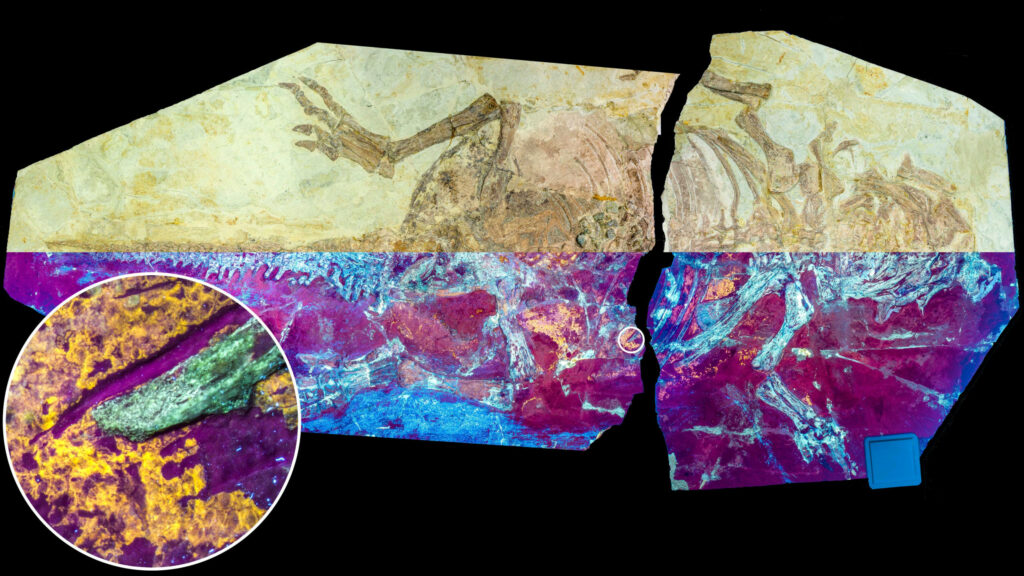The earliest feathered dinosaurs may have evolved their bird-like features while still retaining lizard-like scales on other parts of their body.
This theory is based on the discovery of a fossilized psittacosaurus, which had scales similar to those of modern reptiles across most of its body, but feather-specific skin on its tail only, according to a new study in the journal Nature Communications.
The presence of two types of skin on the fossil implies that dinosaurs may have retained reptile skin as protection while experimenting with feathers in certain areas in the early days of feather evolution.
Image of the fossilized psittacosaurus specimen under natural (upper half) and UV light (lower half) showing the orange-yellow fluorescence of the fossilized skin (inset). The dinosaur was found to have feathered skin on some parts…
Zixiao Yang
Dinosaurs were initially thought to be exclusively scaly, like modern-day lizards and crocodiles, but paleontologists slowly started finding evidence of some species having feathers, such as evidence of quill knobs—places where the feathers were anchored to the bone—on forearm bones, impressions of feathers near the bones, and fossilized feathers themselves.
However, scientists haven’t been entirely certain of the details of the evolutionary transition from having scaly skin to having feather-adapted skin.
“The evolution of feathers is associated with novel skin ultrastructures, but the fossil record of these changes is poor and thus the critical transition from scaled to feathered skin is poorly understood,” the researchers wrote in the paper.
Now, fossilized skin samples from a psittacosaurus that lived around 130 million years ago have shown that this species had some areas of scaly skin and other areas with feathers.
This fossil was discovered in China and was found to only have had feathers on its tail. Using ultraviolet fluorescence and electron microscopy, the researchers found that most of its body was covered in two layers of skin that resembled the layers seen in modern reptiles, as well as melanosomes, which affect color, that may have been responsible for color patterning just like present-day lizards. Fragments of skin from the tail region more strongly resembled the skin of modern birds.
Electron microscopy image of the fossil skin, showing mineralized cell layers.
Zixiao Yang
This implies that dinosaurs may have retained their scaly reptile skin during the early days of feather evolution.
“Collectively, the fossil evidence supports partitioning of skin development in psittacosaurus: a reptile-type condition in non-feathered regions and an avian-like condition in feathered regions,” the researchers wrote in the paper.
“Retention of the plesiomorphic skin condition in non-feathered regions would have maintained the essential protective function of the skin against abrasion, desiccation and pathogens. This may have been vital for the survival of early feathered animals and, critically, the retention of feather genes during early feather evolution.”
Do you have a tip on a science story that Newsweek should be covering? Do you have a question about dinosaurs? Let us know via science@newsweek.com.
Uncommon Knowledge
Newsweek is committed to challenging conventional wisdom and finding connections in the search for common ground.
Newsweek is committed to challenging conventional wisdom and finding connections in the search for common ground.
>>> Read full article>>>
Copyright for syndicated content belongs to the linked Source : Newsweek – https://www.newsweek.com/dinosaur-skin-fossil-feathered-scales-evolution-1902681
